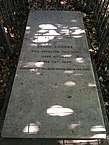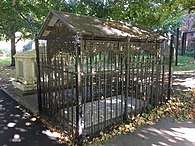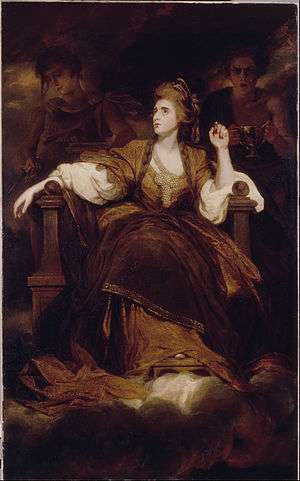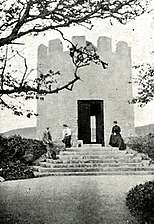Sarah Siddons
| Sarah Siddons | |
|---|---|
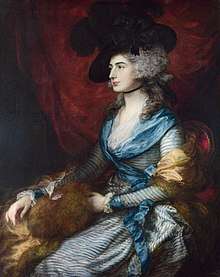 1785 portrait by Thomas Gainsborough | |
| Born |
Sarah Kemble 5 July 1755 Brecon, Wales |
| Died |
8 June 1831 (aged 75) London, England |
| Resting place | Saint Mary's Cemetery, Paddington Green, London, England |
| Occupation | Actress |
| Spouse(s) | William Siddons |
| Parent(s) | Roger Kemble and Sarah Ward |
| Relatives | Mary Frances Scott-Siddons (great-granddaughter) |
Sarah Siddons (née Kemble; 5 July 1755 – 8 June 1831)[1] was a Welsh-born English actress, the best-known tragedienne of the 18th century.
She was the elder sister of John Philip Kemble, Charles Kemble, Stephen Kemble, Ann Hatton, and Elizabeth Whitlock, and the aunt of Fanny Kemble. She was most famous for her portrayal of the Shakespearean character, Lady Macbeth, a character she made her own,[1] as well as for fainting at the sight of the Elgin Marbles in London.[2]
The Sarah Siddons Society, founded in 1952, continues to present the Sarah Siddons Award annually in Chicago to a distinguished actress.
Biography
Early life
Siddons was born Sarah Kemble in Brecon, Brecknockshire, Wales, the eldest daughter of Roger Kemble, a Roman Catholic, and Sarah "Sally" Ward, a Protestant. Sarah and her sisters were raised in their mother's faith and her brothers were raised in their father's faith. Roger Kemble was the manager of a touring theatre company, the Warwickshire Company of Comedians.[3]
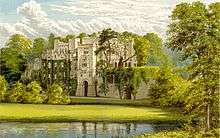
Although the theatre company included most members of the Kemble family, Siddons' parents initially disapproved of her choice of profession. At that time, acting was only beginning to become a respectable profession for a woman.[4]
From 1770 until her marriage in 1773, Siddons served as a lady's maid and later as companion to Lady Mary Bertie Greatheed at Guy's Cliffe near Warwick.[5]:3 Lady Greatheed was the daughter of the Duke of Ancaster; her son, Bertie Greatheed, was a dramatist who continued the family's friendship with Siddons.[5]:18
Career
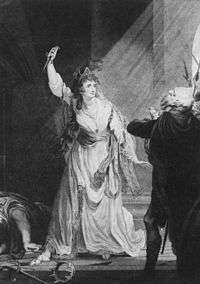
In 1774, Siddons won her first success as Belvidera in Thomas Otway's Venice Preserv'd. This brought her to the attention of David Garrick, who sent his deputy to see her as Calista in Nicholas Rowe's Fair Penitent, the result being that she was engaged to appear at the Theatre Royal, Drury Lane. Owing to inexperience as well as other circumstances, her first appearances as Portia and in other parts were not well received and she received a note from the manager of Drury Lane stating that her services would not be required. She was, in her own words, "banished from Drury Lane as a worthless candidate for fame and fortune".[1]
In 1777, she went on "the circuit" in the provinces. For the next six years she worked in provincial companies, in particular York and Bath. Her first appearance at Bath's Old Orchard Street Theatre was in autumn 1778 at a salary of £3 per week (equivalent to £351 in 2016, or approximately $450).[6] This amount grew as her performances became better known, and as she began to appear in Bristol at the Theatre Royal, King Street (which now houses the Bristol Old Vic), also run by John Palmer. Siddons lived with her husband and children in a Georgian house at 33 The Paragon in Bath, until her final performance there in May 1782.[7]
Having gradually built up a reputation, her next Drury Lane appearance, on 10 October 1782, could not have been more different. She was an immediate sensation playing the title role in Garrick's adaptation of a play by Thomas Southerne, Isabella, or, The Fatal Marriage.
.jpg)
Her most famous role was that of Lady Macbeth; it was the grandeur of her emotions as she expressed Lady Macbeth's murderous passions that held her audiences spellbound. In Lady Macbeth she found the highest and best scope for her acting abilities. She was tall and had a striking figure, brilliant beauty, powerfully expressive eyes, and solemn dignity of demeanour which enabled her to claim the character as her own.[1]
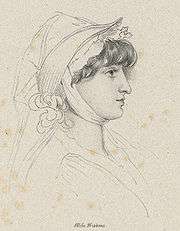
After Lady Macbeth she played Desdemona, Rosalind, Ophelia and Volumnia, all with great success; but it was as Queen Catherine in Henry VIII that she discovered a part almost as well adapted to her acting powers as that of Lady Macbeth.[1] She once told Samuel Johnson that Catherine was her favourite role, as it was the most natural.[8]
It was the beginning of twenty years in which she was the undisputed queen of Drury Lane. Her celebrity status has been called "mythical" and "monumental," and by "the mid-1780s Siddons was established as a cultural icon, along with Hannah Murphy, another theatre great of the time."[4] She mixed with the literary and social elites of London society, and her acquaintances included Samuel Johnson, Edmund Burke, Hester Thrale Piozzi, and William Windham. She nevertheless continued to act in the provinces, appearing at The Theatre, Leeds in 1786 and on several other occasions.[9]
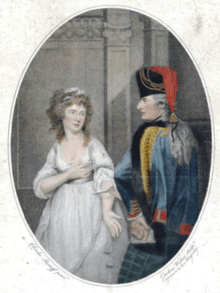
In 1802 she left Drury Lane and subsequently appeared from time to time on the stage of the rival establishment, Covent Garden. It was there, on 29 June 1812, that she gave perhaps the most extraordinary farewell performance in theatre history. She was playing her most famous role, Lady Macbeth, and the audience refused to allow the play to continue after the end of the sleepwalking scene. Eventually, after tumultuous applause from the pit, the curtain reopened and Siddons was discovered sitting in her own clothes and character – whereupon she made an emotional farewell speech to the audience lasting eight minutes.
Mrs. Siddons formally retired from the stage in 1812, but occasionally appeared on special occasions. Her last appearance was on 9 June 1819 as Lady Randolph in John Home's Douglas.[1]
Acting power
.jpg)
Theatre biographer Henry Barton Baker wrote:
Wonderful stories are told of her powers over the spectators. Macready relates that when she played Aphasia in Tamburlaine, after seeing her lover strangled before her eyes, so terrible was her agony as she fell lifeless upon the stage, that the audience believed she was really dead, and only the assurance of the manager could pacify them. One night Charles Young was playing Beverly to her Mrs. Beverly in The Gamester, and in the great scene was so overwhelmed by her pathos that he could not speak. Unto the last she received the homage of the great; even the Duke of Wellington attended her receptions, and carriages were drawn up before her door nearly all day long.[10]
On the night of 2 May 1797, Sarah Siddons's character of Agnes in Lillo's Fatal Curiosity suggested murder with "an expression in her face that made the flesh of the spectator creep." In the audience was Crabb Robinson, whose respiration grew difficult. Robinson went into a fit of hysterics and was nearly ejected from the theatre.[11]
Siddons occasionally gave public readings of plays, and the Scottish poet/playwright Joanna Baillie recorded her thoughts of several performances given in 1813. Despite her reservations about Siddon's "frequent bursts of voice beyond what natural passion warranted," Baillie wrote to Sir Walter Scott, "take it all in all was fine & powerful acting; and when it has ceased we of this generation can never look to see the like again."[12]
Marriage and children
In 1773, at the age of 18, she married William Siddons, an actor. After 30 years, the marriage became strained and informally ended with their separation in 1804.[5]:29 William died in 1808.
Sarah Siddons gave birth to seven children, five of whom she outlived:[5][13]
- Henry Siddons (1774–1815), an actor and theatre manager in Edinburgh
- Sarah Martha (Sally) Siddons (1775–1803)
- Maria Siddons (1779–1798)
- Frances Emilia Siddons (b. 1781), died in infancy
- Elizabeth Ann Siddons (1782–1788), died in childhood
- George John Siddons (1785–1848), a Customs official in India
- Cecilia Siddons (1794–1868), who married George Combe in 1833 and lived in Edinburgh
Legacy
Death and burial
Sarah Siddons died in 1831 in London. She was interred in Saint Mary's Cemetery at Paddington Green.[1] The churchyard was converted into a public park (St Mary's Gardens) in 1881, and most stones were cleared at that time. Siddons' gravestone was one of the few to be preserved, and it remains in good condition beneath a wrought iron canopy, despite some erosion and the modern addition of a protective cage.[14]
Portraits and statues
Siddons sat for numerous artists, and her portraits include many that depict her in costume portraying a theatrical role.
- Sir Thomas Lawrence first painted Siddons at Bath in 1782,[15] and produced at least fourteen portraits of her over the next 22 years.[16] The last of these, an 1804 full-length portrait, is on display at Tate Britain.[15]
- Sir Joshua Reynolds painted his famous portrait, Mrs. Siddons as the Tragic Muse, in 1784. He told her that he had signed it on the hem of her dress because he had "resolved to go down to posterity on the hem of your garment." It now hangs at The Huntington in San Marino, California.
- A 1785 portrait by Thomas Gainsborough is displayed in London's National Gallery.
- A portrait of Siddons is displayed in the church hall of St Mary on Paddington Green, near Siddons' grave in the former churchyard (now St Mary's Gardens).[14]
- Also on Paddington Green, a statue of Siddons overlooks the Harrow Road.
- A statue of Siddons by sculptor Thomas Campbell stands in the chapel of St Andrew in Westminster Abbey. The statue holds a scroll, and the inscription reads: "Sarah Siddons. Born at Brecon July 5, 1755. Died in London June 8, 1831."
Other memorials
- Siddons Tower, a folly tower erected c. 1777 on the water's edge at Rostellan near Cork Harbour in Ireland,[17] was named in Siddons' honour by Murrough O'Brien, Lord Inchiquin, after he had entertained the actress at Rostellan House.[18]
- Siddons Lane, a small street in Marylebone near the site of a house in which she once lived, was named after her.[19]
- Siddons' birthplace, an inn in Brecon, Wales, is now known as The Sarah Siddons Inn. In 1755, when Siddons was born in lodgings on an upper floor, it was a tavern called The Shoulder of Mutton.[20]
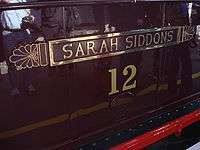
- In 1923, London's Metropolitan Railway brought into service an electric locomotive named Sarah Siddons, No. 12. The locomotive remained in service along with others like it on the London Underground Metropolitan line until 1961. Painted a maroon colour, she is now the only one of the original twenty locomotives to remain preserved in working order.[21]
In popular culture
American director Joseph L. Mankiewicz used the 1784 portrait by Reynolds extensively in his film All About Eve, winner of the 1950 Academy Award for Best Picture. The portrait is seen at the top of an entrance staircase in Margo Channing's apartment, appearing throughout a party scene, and emphasized by a close-up with which the scene ends. Mankiewicz also invented the (then) fictitious Sarah Siddons Society for the film, along with its award, a statuette modelled upon the Reynolds painting. The film opens with a close-up of the statuette, and ends with a character holding it.[22]
Actress Bette Davis, who played Margo Channing in the film, posed as Siddons in a 1957 re-creation of the Reynolds portrait staged as part of the Pageant of the Masters.[22]
In April 2010, BBC Radio 4's Woman's Hour Drama presented Sarah Siddons: Life in Five Sittings, a radio drama by David Pownall about the long relationship between Siddons and artist Thomas Lawrence, in five 15-minute parts.[23]
The Sarah Siddons Award
When the film All About Eve was released in 1950, the "Sarah Siddons Award for Distinguished Achievement" depicted in its opening scene was a purely fictitious award. However, in 1952, a small group of distinguished Chicago theatergoers formed the Sarah Siddons Society, and began to give a genuine award by that name.[24] The now-prestigious Sarah Siddons Award is presented annually in Chicago, with a trophy modelled on the statuette of Siddons awarded in the film.[24] Past honorees include Bette Davis and Celeste Holm.[25]
See also
References
![]()
- 1 2 3 4 5 6 7

- ↑ Smith, A.H. (1916). "Lord Elgin and his Collection". The Journal of Hellenic Studies. The Society for the Promotion of Hellenic Studies. 36: 163–372. doi:10.2307/625773.
- ↑ McManaway, James G. (1949). "The Two Earliest Prompt Books of Hamlet". The Papers of the Bibliographical Society of America. Bibliographical Society of America. 43 (3): 305. eISSN 2377-6528. ISSN 0006-128X. JSTOR 24298457 – via JSTOR. (Subscription required (help)).
- 1 2 "Siddons [née Kemble], Sarah (1755–1831)". Oxford Dictionary of National Biography (online ed.). Oxford University Press. 24 May 2008 [2004]. doi:10.1093/ref:odnb/25516.
- 1 2 3 4 Highfill, Philip H.; Burnim, Kalman A.; Langhans, Edward A. (1991). A Biographical Dictionary of Actors, Actresses, Musicians, Dancers, Managers, and Other Stage Personnel in London, 1660–1800, Volume 14. Carbondale, IL: Southern Illinois University Press. pp. 32–33. ISBN 978-0-8093-1526-0.
- ↑ UK Retail Price Index inflation figures are based on data from Clark, Gregory (2017). "The Annual RPI and Average Earnings for Britain, 1209 to Present (New Series)". MeasuringWorth. Retrieved November 6, 2017.
- ↑ Lowndes, William (1982). The Theatre Royal at Bath. Redcliffe. pp. 25–27. ISBN 978-0905459493.
- ↑ Boswell, James (1791). The Life of Samuel Johnson, LL.D.
- ↑ Grahame, Suzanne (2003). "The Theatre". Discovering Leeds: The Theatres – Development. Leeds City Council. Retrieved 17 December 2013.
- ↑ Baker, Henry Barton (1904). History of the London Stage and Its Famous Players (1576–1903). New York: E.P. Dutton & Co. p. 131.
- ↑ Campbell, Thomas (1834). Life of Mrs. Siddons, Vol. II. London: Effingham Wilson. p. 212.
- ↑ Baillie, Joanna (2010). Thomas McLean, ed. Further Letters of Joanna Baillie. Madison, NJ: Fairleigh Dickinson Univ Press. p. 54. ISBN 978-0-8386-4149-1.
- ↑

- 1 2 Matthews, Peter (2017). Who's Buried Where in London. Bloomsbury Publishing. p. 37. ISBN 978-1-78442-202-8.
- 1 2 Levey, Michael (2005). Sir Thomas Lawrence. Yale University Press. p. 42. ISBN 0-300-10998-9.
- ↑ Parsons, Florence Mary Wilson (1909). The Incomparable Siddons. Methuen. p. 60.
- ↑ Tone, Theobald Wolfe; Radcliff, John; Jebb, Richard (1998). Belmont Castle, Or, Suffering Sensibility. Lilliput Press. p. 66 n.1. ISBN 978-1-901866-06-3.
- ↑ Howley, James (2004). The Follies and Garden Buildings of Ireland. Yale University Press. pp. 63–64. ISBN 978-0-300-10225-3.
- ↑ McKenzie, Louisa (2015). "The Ghost of Sarah Siddons". In Riddaway, Mark; Upsall, Carl. Marylebone Lives: Rogues, Romantics and Rebels – Character Studies of Locals Since the Eighteenth Century. Spiramus Press Ltd. p. 54. ISBN 9781910151037.
- ↑ Carradice, Phil (4 July 2011). "Sarah Siddons, tragic actress". Wales History (blog). BBC. Archived from the original on 2018-09-28.
- ↑ Video of Sarah Siddons (the locomotive) on a 'special' on the London Underground on YouTube. Retrieved 22 August 2008.
- 1 2 "The Legend of Sarah Siddons: All About Eve and the Sarah Siddons Society". The Huntington Library, Art Collections, and Botanical Gardens. 1999. Archived from the original on 25 July 2008.
- ↑ "Sarah Siddons: Life in Five Sittings". Woman's Hour Drama. BBC Radio 4. 12–16 April 2010. Archived from the original on 17 April 2010.
- 1 2 "About Us". Sarah Siddons Society. Archived from the original on 21 November 2014. Retrieved 27 February 2014.
- ↑ "The Sarah Siddons Society Awardees". Sarah Siddons Society. Retrieved 27 February 2014.
Further reading
- Pascoe, Judith (2011). The Sarah Siddons Audio Files: Romanticism and the Lost Voice. Ann Arbor: University of Michigan Press. ISBN 978-0-472-02795-8.
- Robinson, Terry F. (2012). "Sarah Siddons". In Burwick, Frederick; Goslee, Nancy Moore; Hoeveler, Diane Long. The Encyclopedia of Romantic Literature. Malden, MA: Wiley-Blackwell. pp. 1252–1261. ISBN 978-1-4051-8810-4.
- Seewald, Jan (2007). Theatrical Sculpture: Skulptierte Bildnisse berühmter englischer Schauspieler (1750–1850), insbesondere David Garrick und Sarah Siddons (in German). München: Herbert Utz Verlag. ISBN 978-3-8316-0671-9.
External links
| Wikimedia Commons has media related to Sarah Siddons. |
